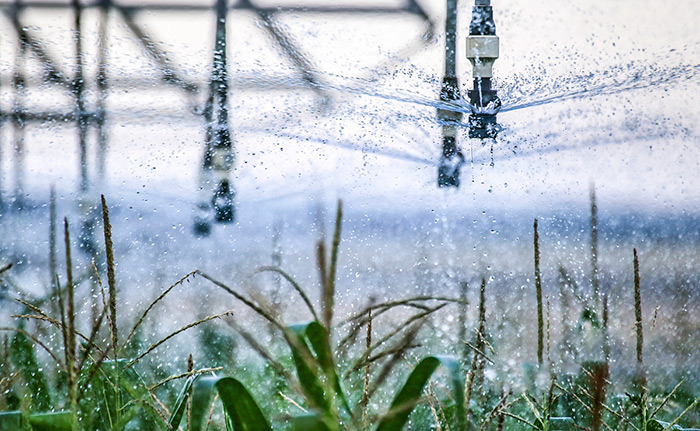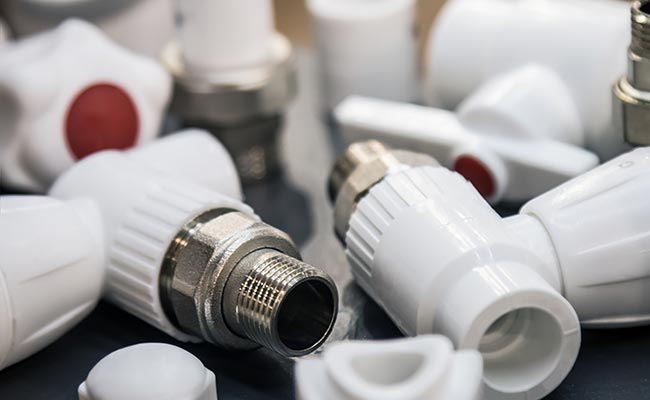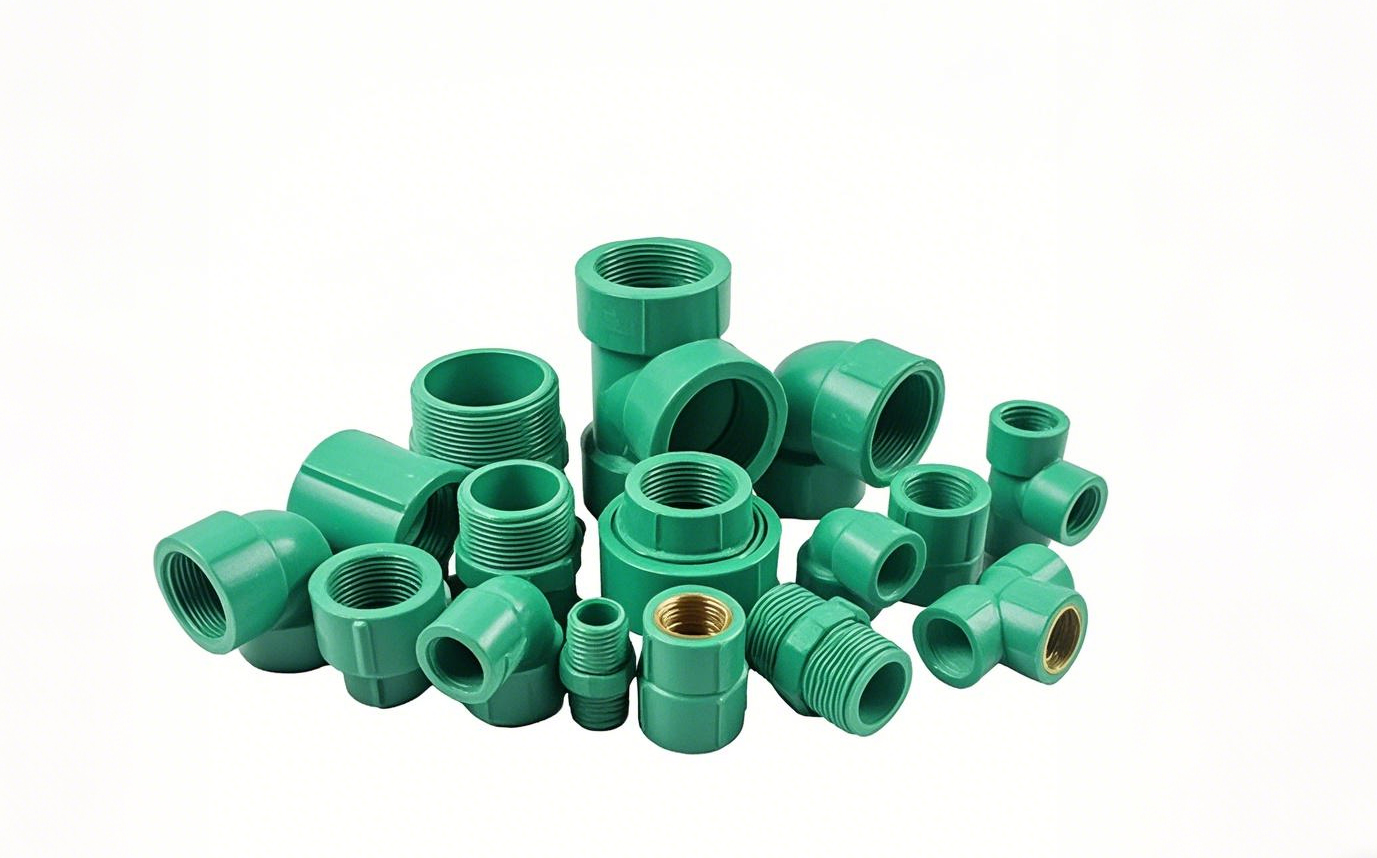
Njẹ o ti ṣe iyalẹnu tẹlẹ kini o jẹ ki eto fifin rẹ ṣiṣẹ laisiyonu ati laisi jijo? Jẹ ki n sọ fun ọ nipa PPR Couplings. Awọn paati ọwọ wọnyi dabi lẹ pọ ti o di ohun gbogbo papọ. Wọn so awọn paipu pọ ni aabo, ni idaniloju ṣiṣan omi laisi awọn n jo idoti eyikeyi. O jẹ iyalẹnu bi iru nkan kekere kan ṣe le ṣe iru iyatọ nla ni ile tabi ibi iṣẹ rẹ.
Awọn gbigba bọtini
- Awọn idapọ PPR ṣe patakifun Plumbing. Wọn darapọ mọ awọn paipu ni wiwọ lati da awọn n jo ati ki o jẹ ki omi n ṣan daradara.
- Awọn iṣọpọ wọnyi lagbara, ma ṣe ipata, wọn le mu ooru mu. Eyi jẹ ki pipe paipu pẹ pẹlu awọn atunṣe diẹ ti o nilo.
- Mu Isopọpọ PPR ti o tọ ti o da lori titẹ eto rẹ ati lilo. Ṣayẹwo nigbagbogbo pe asopọ naa ni ibamu pẹlu awọn aini fifin rẹ.
Kini Isopọpọ PPR kan?
Jẹ ki a lọ jinle sinu ohun ti o jẹ ki Isopọpọ PPR ṣe pataki. Awọn paati kekere ṣugbọn alagbara wọnyi jẹ ẹhin ti awọn ọna ṣiṣe paipu ode oni. Wọn so awọn paipu pọ lainidi, ni idaniloju ṣiṣan omi daradara laisi awọn n jo. Ṣugbọn kini gangan wọn ṣe, ati bawo ni wọn ṣe n ṣiṣẹ? E je ki n ya lule fun e.
Ohun elo ati Awọn ohun-ini ti Awọn Isopọpọ PPR
Awọn idapọmọra PPR jẹ lati Polypropylene ID Copolymer (PPR), ohun elo ti a mọ fun agbara to ṣe pataki ati isọpọ. Eyi kii ṣe ṣiṣu eyikeyi nikan-o jẹ polima ti o ni iṣẹ giga ti a ṣe apẹrẹ lati mu awọn ibeere ti awọn ọna ṣiṣe paipu mu.
Eyi ni ohun ti o jẹ ki Awọn Isopọpọ PPR ṣe pataki:
- Agbara ati Lile: Fillers bi gilasi awọn okun ati talc ti wa ni nigbagbogbo fi kun lati mu agbara fifẹ ati rigidity. Eyi jẹ ki wọn jẹ pipe fun awọn ohun elo titẹ-giga.
- Kemikali Resistance: PPR Couplings koju awọn olomi, acids, ati awọn kemikali miiran, ni idaniloju pe wọn kii yoo dinku ni akoko pupọ.
- Gbona Iduroṣinṣin: Awọn afikun pataki ṣe ilọsiwaju agbara wọn lati koju awọn iwọn otutu ti o ga, ṣiṣe wọn ni apẹrẹ fun awọn ọna omi gbona ati tutu.
Ni otitọ, awọn idanwo yàrá ti fihan bi awọn ohun elo wọnyi ṣe gbẹkẹle:
| Idanwo Iru | Idi |
|---|---|
| Oṣuwọn Sisan Yo (MFR) | Ṣe idaniloju awọn abuda sisan ohun elo to dara. |
| Atako Ipa | Ṣe idaniloju agbara paipu labẹ agbara ojiji. |
| Ti nwaye Titẹ | Jẹrisi pipes le withstand pàtó kan titẹ. |
| Agbara Hydrostatic Igba pipẹ | Ṣe asọtẹlẹ iṣẹ ṣiṣe ọdun 50. |
Awọn ohun-ini wọnyi jẹ ki Awọn Asopọmọra PPR jẹ yiyan igbẹkẹle ninu awọn ọna ṣiṣe paipu ni kariaye. Njẹ o mọ pe ọja Yuroopu fun awọn paipu PPR ati awọn ibamu jẹ idiyele ni $ 5.10 bilionu ni ọdun 2023? O jẹ iṣẹ akanṣe lati dagba ni imurasilẹ, o ṣeun si ibeere fun awọn ojutu fifin to munadoko. Jẹmánì, Faranse, ati UK n ṣakoso idiyele naa, ni idaniloju awọn iṣedede didara ga fun awọn ọja wọnyi.
Bawo ni Awọn Isopọpọ PPR Ṣiṣẹ ni Awọn ọna Plumbing
Bayi, jẹ ki ká soro nipa bi awon couplings kosi ṣiṣẹ. Fojuinu pe o n so paipu meji pọ. Isopọpọ PPR kan n ṣiṣẹ bi afara, ṣiṣẹda asopọ to ni aabo ati jijo. Aṣiri naa wa ninu apẹrẹ wọn ati awọn ohun-ini ohun elo.
Eyi ni bii wọn ṣe ṣaṣeyọri eyi:
- Awọn ilọsiwaju ohun elo: Awọn iṣọpọ PPR jẹ rọ sibẹsibẹ lagbara, pẹlu ooru ti o dara julọ ati resistance kemikali. Eyi ṣe idaniloju pe wọn le mu awọn aapọn ti paipu lojoojumọ.
- Imudara Awọn ilana Isopọpọ: Modern couplings lo aseyori ọna bi titari-fit tabi tẹ-titiipa ise sise. Awọn wọnyi ni irọrun fifi sori ẹrọ ati dinku awọn aye ti awọn n jo.
- Awọn Imọ-ẹrọ Smart: Diẹ ninu awọn eto paapaa ṣepọ awọn sensọ lati ṣe atẹle ṣiṣan omi, iwọn otutu, ati titẹ ni akoko gidi. Eyi ṣe iranlọwọ lati rii awọn n jo ni kutukutu ati ṣe idaniloju iṣẹ ṣiṣe to dara julọ.
Lati fun ọ ni aworan ti o han gbangba, eyi ni lafiwe ti bii PPR ṣe nṣe lodi si awọn ohun elo miiran:
| Ohun elo paipu | Titẹ Irekọja ti o pọju (ọpa) | Igara (µε) | Afiwera to Irin Pipeline |
|---|---|---|---|
| Irin | 13.80 | 104.73 | Itọkasi |
| Ejò | 16.34 | 205.7 | + 15.65% titẹ, 3x igara |
| PPR | 14.43 | Ọdun 1619.12 | -5% titẹ, 15x igara |
| uPVC | 12.48 | 1119.49 | -12,4% titẹ, 10x igara |
| GRP | 14.51 | 383.69 | + 5% titẹ, igara 3x |
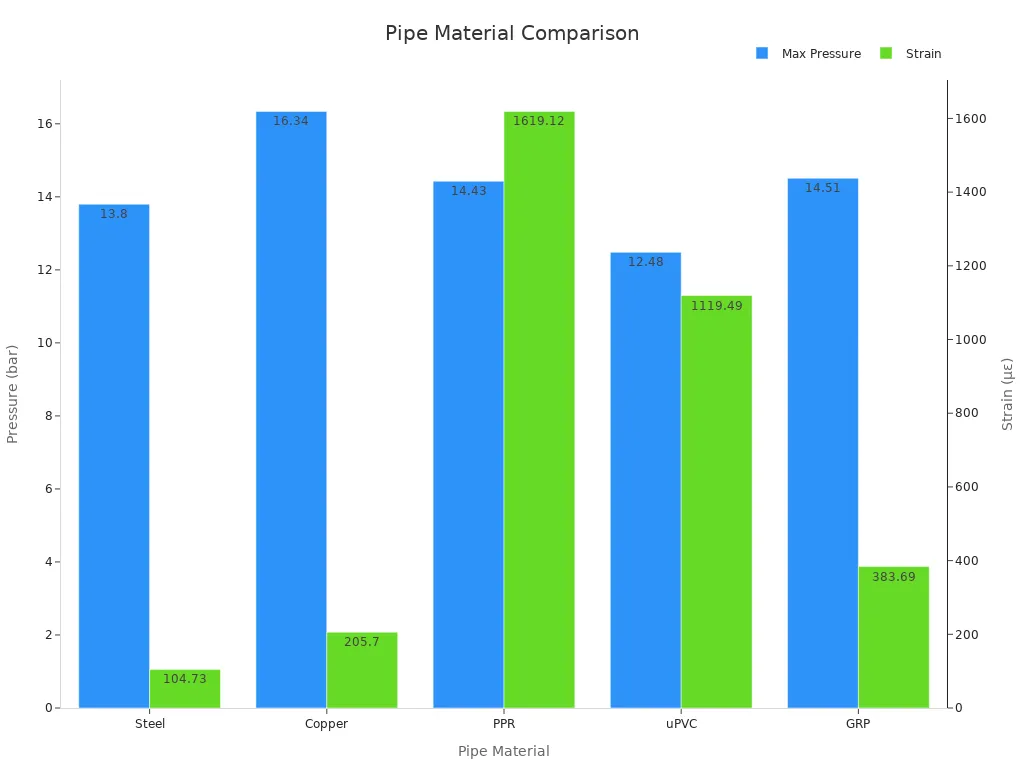
Bi o ti le rii, Awọn Isopọpọ PPR kọlu iwọntunwọnsi pipe laarin agbara ati irọrun. Wọn ju ọpọlọpọ awọn omiiran lọ, paapaa nigbati o ba de si mimu igara ati mimu agbara duro lori akoko. Ti o ni idi ti wọn jẹ yiyan-si yiyan fun ibugbe mejeeji ati awọn ọna ẹrọ paipu iṣowo.
Awọn anfani ti PPR Couplings
Agbara ati Resistance si Ipaba
Nigba ti o ba de si Plumbing, agbara ni ohun gbogbo. O fẹ nkankan ti o duro, otun? Ti o ni ibi ti PPR Couplings tàn. Awọn asopọ kekere wọnyi ni a kọ lati koju idanwo akoko. Ko dabi awọn ohun elo irin, wọn ko ipata tabi baje. Eyi jẹ ki wọn jẹ pipe fun awọn eto omi, paapaa ni awọn agbegbe ti o ni lile tabi omi ti a ṣe itọju kemikali.
Mo ti rii bii awọn ohun elo ibile bii irin tabi bàbà ṣe le dinku ni akoko pupọ. Wọn dagbasoke awọn n jo, ati rirọpo wọn le jẹ wahala. Ṣugbọn pẹlu PPR Couplings, o ko ni lati dààmú nipa ti. Idaabobo kemikali wọn ṣe idaniloju pe wọn wa ni idaduro, paapaa nigba ti o farahan si awọn nkan ti o lagbara. Eyi tumọ si awọn atunṣe diẹ ati itọju diẹ ni igba pipẹ. O dabi nini ọrẹ ti o gbẹkẹle ti ko jẹ ki o ṣubu.
Ifarada Iwọn otutu-giga ati Ọrẹ-Eko
Njẹ o ti ṣe iyalẹnu bi awọn ọna ṣiṣe paipu ṣe mu omi gbona laisi fifọ? PPR Couplings ti wa ni apẹrẹ fun o kan na. Wọn le ṣiṣẹ nigbagbogbo ni awọn iwọn otutu ti o wa lati -20 ° C si 95 ° C. Paapaa lakoko awọn oke igba kukuru ti o to 110 ° C, wọn ṣetọju iduroṣinṣin igbekalẹ wọn. Iyẹn jẹ iwunilori, ṣe kii ṣe bẹẹ?
Eyi ni ohun ti o jẹ ki wọn ṣe pataki:
- Ni 95 ° C, wọn le mu awọn titẹ soke si 3.2 MPa laisi fifọ.
- Lẹhin awọn iyipo igbona 500 laarin 20°C ati 95°C, wọn ko fi ami ikuna han.
Ipele iṣẹ yii ko ni ibamu nipasẹ awọn ohun elo bii PVC, eyiti o rọ ni awọn iwọn otutu ti o ga julọ. Pẹlupẹlu, Awọn Isopọpọ PPR jẹ ore-ọrẹ. Wọn ṣe lati awọn ohun elo atunlo, dinku ipa ayika wọn. Nitorinaa, nipa yiyan PPR, kii ṣe idoko-owo nikan ni didara — iwọ tun n ṣe yiyan alawọ ewe.
Ṣiṣe-iye owo fun Lilo Igba pipẹ
Jẹ ká soro nipa owo. Plumbing le jẹ gbowolori, ṣugbọn PPR Couplings pese a iye owo-doko ojutu. Lakoko ti idoko-owo akọkọ le dabi ti o ga ju awọn aṣayan miiran lọ, awọn ifowopamọ igba pipẹ jẹ eyiti a ko le sẹ. Ronu nipa rẹ-diẹ itọju, awọn iyipada diẹ, ati ṣiṣe to dara julọ. Iyẹn jẹ ipo win-win.
Awọn ijinlẹ fihan pe awọn ọna ṣiṣe PPR fipamọ awọn onile ati awọn iṣowo ni iye pataki ni akoko pupọ. Agbara wọn tumọ si pe iwọ kii yoo ni lati ṣe pẹlu awọn atunṣe loorekoore. Pẹlupẹlu, ṣiṣe agbara wọn ṣe iranlọwọ lati dinku awọn owo-iwUlO. O dabi gbigba Bangi diẹ sii fun owo rẹ. Nigbati o ba gbero iye gbogbogbo, Awọn Isopọpọ PPR jẹ yiyan ọlọgbọn fun ẹnikẹni ti n wa lati fipamọ ni igba pipẹ.
Bii o ṣe le Yan Isopọpọ PPR Ọtun
Yiyan Isopọpọ PPR ti o tọle rilara ti o lagbara, ṣugbọn ko ni lati jẹ. Jẹ ki n rin ọ nipasẹ awọn ifosiwewe bọtini, awọn ohun elo ti o wọpọ, ati diẹ ninu awọn imọran ọwọ fun fifi sori ẹrọ ati itọju. Ni ipari, iwọ yoo ni igboya ni ṣiṣe yiyan ti o dara julọ fun awọn iwulo idọti rẹ.
Okunfa lati ro fun ibamu
Nigbati o ba yan Isopọpọ PPR, ibaramu jẹ ohun gbogbo. O nilo lati baramu idapọ si titẹ eto rẹ, iwọn otutu, ati ohun elo. Eyi ni itọsọna iyara lati ṣe iranlọwọ fun ọ lati pinnu:
| Iru | Ipa Ṣiṣẹ (Mpa) | Awọn ohun elo | Odi Sisanra Range |
|---|---|---|---|
| PN10 | 1.0 MPa | Awọn ọna omi tutu, irigeson titẹ kekere | 2.0-3.5 mm |
| PN16 | 1.6 MPa | Multistory ile omi ipese awọn ọna šiše | 2.3-4.2 mm |
| PN20 | 2.0 MPa | Alapapo iwọn otutu giga, fifin ile-iṣẹ | 2,8-5,4 mm |
| PN25 | 2.5 MPa | Awọn ọna ẹrọ ti o ga-titẹ, awọn ile-iṣẹ pataki | 3.5-6.5 mm |
Fun apẹẹrẹ, ti o ba n ṣiṣẹ lori eto omi tutu, PN10 ni lilọ-si rẹ. Ṣugbọn fun awọn eto nya si titẹ giga, PN25 jẹ yiyan ti o dara julọ. Nigbagbogbo ṣayẹwo awọn pato lati rii daju pe ibamu.
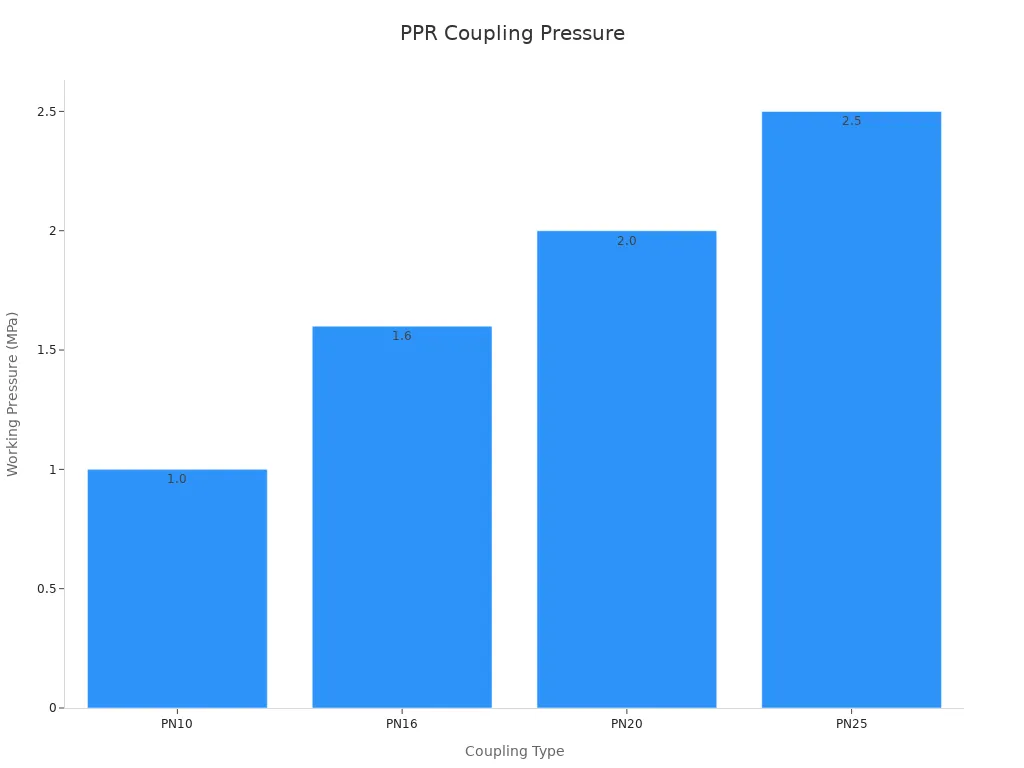
Awọn ohun elo ti o wọpọ ni Ibugbe ati Plumbing Iṣowo
PPR Couplings ni o wa ti iyalẹnu wapọ. Mo ti rii wọn ti a lo ninu ohun gbogbo lati awọn paipu ile ti o rọrun si awọn eto ile-iṣẹ eka. Eyi ni diẹ ninu awọn ohun elo ti o wọpọ:
- Awọn ọna ipese omi inu ile
- Ifijiṣẹ omi mimu (awọn eto omi gbona ati tutu)
- Radiant pakà alapapo nẹtiwọki
- Plumbing ile ise fun kemikali ati ounje ile ise
- Agricultural irigeson awọn ọna šiše
Iseda ti kii ṣe majele ati resistance si ipata jẹ ki wọn jẹ apẹrẹ fun awọn eto omi mimu ati awọn fifi sori ẹrọ alapapo. Boya o jẹ onile tabi olugbaisese, awọn idapọ wọnyi jẹ yiyan ti o gbẹkẹle.
Fifi sori ati Italolobo Itọju
Fifi ati mimu awọn Isopọpọ PPR rọrun ju ti o le ronu lọ. Eyi ni diẹ ninu awọn imọran ti Mo ti rii iranlọwọ:
- Ilana fifi sori ẹrọ: Lo socket seeli alurinmorin. Ge paipu, gbona awọn opin, ki o darapọ mọ wọn ni aabo.
- Ibi ipamọ ati mimu: Jeki awọn iwọn otutu laarin -20°C ati +40°C nigba ipamọ. Dabobo awọn idapọmọra lati itọka UV ati lo awọn fila lati yago fun idoti.
- Awọn iṣeduro Itọju: Ṣayẹwo eto nigbagbogbo. Fọ rẹ lorekore lati yọ idoti kuro. Adirẹsi n jo lẹsẹkẹsẹ ki o tọju igbasilẹ gbogbo awọn atunṣe.
Nipa titẹle awọn igbesẹ wọnyi, iwọ yoo rii daju pe eto fifin rẹ duro daradara ati laisi wahala fun awọn ọdun.
PPR Couplings ni o wa game-changers ni Plumbing. Wọn jẹ ti o tọ, agbara-daradara, ati ore-aye. Awọn asopọpọ wọnyi dinku pipadanu ooru, fi agbara pamọ, ati awọn ifẹsẹtẹ erogba kekere. Eyi ni bi wọn ṣe ṣe afiwe si awọn ohun elo miiran:
| Metiriki | Awọn Isopọpọ PPR | Awọn ohun elo miiran (Irin/Nja) |
|---|---|---|
| Gbona Conductivity | Kekere | Ga |
| Lilo Agbara | Ga | Déde |
| Ipa Ayika | Rere | Ayípadà |
Pẹlu igbesi aye gigun wọn ati ṣiṣe iye owo, wọn jẹ pipe fun awọn ile ati awọn iṣowo. Kilode ti o ko ṣe ṣawari Awọn Isopọpọ PPR fun iṣẹ-ṣiṣe Plumbing atẹle rẹ? Iwọ yoo nifẹ awọn abajade!
FAQ
Kini o jẹ ki Awọn Isopọpọ PPR dara ju awọn ohun elo irin lọ?
PPR Couplings ko ipata tabi baje. Wọn fẹẹrẹ fẹẹrẹ, ti o tọ, ati ore-ọrẹ. Pẹlupẹlu, wọn rọrun lati fi sori ẹrọ ati ṣetọju ni akawe si awọn aṣayan irin.
Imọran:Yan Awọn Isopọmọra PPR fun awọn ọna ṣiṣe pipọ pipẹ lai si wahala ti ipata.
Njẹ PPR Couplings le mu awọn iwọn otutu ti o ga julọ?
Nitootọ! Wọn ṣiṣẹ daradara laarin -20 ° C ati 95 ° C. Paapaa awọn oke igba kukuru ti 110°C kii yoo ba wọn jẹ. Wọn ṣe fun awọn eto omi gbona ati tutu.
Ṣe Awọn Isopọpọ PPR jẹ ailewu fun omi mimu?
Bẹẹni, wọn kii ṣe majele ti ati ominira lati awọn kemikali ipalara. Wọn jẹ apẹrẹ fun awọn eto omi mimu, aridaju mimọ ati ifijiṣẹ omi ailewu.
Akiyesi:Idaabobo kemikali wọn jẹ ki wọn jẹ pipe fun ibugbe ati lilo iṣowo.
Akoko ifiweranṣẹ: Oṣu Karun-13-2025


